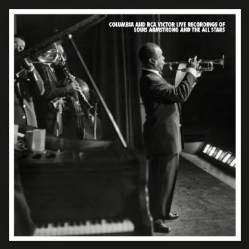 Through a combination of intricate research and unbridled enthusiasm, Ricky Riccardi has become the 21st century’s foremost expert on Louis Armstrong. His book “What a Wonderful World” called for a re-evaluation of Armstrong’s later years, and a new Mosaic set, “Columbia and RCA Victor Live Recordings of Louis Armstrong and the All-Stars”, acts as a companion volume, amplifying Riccardi’s fervent opinions through the music itself. Riccardi wrote a 27,000 word essay for this 9-CD set, and he researched the original tapes and sessions with the assistance of Armstrong’s Columbia producer, George Avakian. While the set is dedicated to Avakian, Riccardi undoes most of the editing and post-production work that Avakian did on these recordings. Riccardi reasons that most of the music is available online, so the Mosaic set offers the opportunity to hear the sessions as they went down, and Riccardi’s extensive notes explain how the pieces were eventually issued. At over 11 hours of music, the set is a huge chunk of Armstrong, even for seasoned fans. The time limits of CDs caused Riccardi and co-producer Scott Wenzel to shuffle the order of the sessions, but since very few fans will listen to this set in one session, it makes sense to break the music into sections. Fortunately, the full-length concerts in this set act as mileposts, with the smaller sessions filling up the discs.
Through a combination of intricate research and unbridled enthusiasm, Ricky Riccardi has become the 21st century’s foremost expert on Louis Armstrong. His book “What a Wonderful World” called for a re-evaluation of Armstrong’s later years, and a new Mosaic set, “Columbia and RCA Victor Live Recordings of Louis Armstrong and the All-Stars”, acts as a companion volume, amplifying Riccardi’s fervent opinions through the music itself. Riccardi wrote a 27,000 word essay for this 9-CD set, and he researched the original tapes and sessions with the assistance of Armstrong’s Columbia producer, George Avakian. While the set is dedicated to Avakian, Riccardi undoes most of the editing and post-production work that Avakian did on these recordings. Riccardi reasons that most of the music is available online, so the Mosaic set offers the opportunity to hear the sessions as they went down, and Riccardi’s extensive notes explain how the pieces were eventually issued. At over 11 hours of music, the set is a huge chunk of Armstrong, even for seasoned fans. The time limits of CDs caused Riccardi and co-producer Scott Wenzel to shuffle the order of the sessions, but since very few fans will listen to this set in one session, it makes sense to break the music into sections. Fortunately, the full-length concerts in this set act as mileposts, with the smaller sessions filling up the discs.
In 1947, Armstrong was touring with a big band (as he had since the early thirties), but press agent Ernie Anderson convinced Armstrong and his manager, Joe Glaser, that the trumpeter should lead a small combo in a concert at New York’s Town Hall. Anderson bankrolled the concert himself and was probably responsible for having the event recorded. The success of this concert brought an end to the big band and the beginning of Louis Armstrong and the All-Stars. However, there are two primary differences between the Town Hall music and the later All-Star repertoire. First of all, there was a greater empha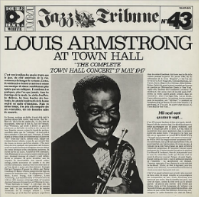 sis on Armstrong’s music of the twenties. Secondly, Armstrong featured himself more at Town Hall than he would with the All-Stars. Fortunately, he was in magnificent form at Town Hall, spontaneously inventing new lyrics on a few occasions, and playing remarkable and daring trumpet solos, which incorporated key portions of his original solos. The concert was a reunion for Armstrong and his longtime friend Jack Teagarden, and significantly, Teagarden is the only member of the band who got a solo feature (once the All-Stars were established, Armstrong typically included features for every member of the band, including vocalist Velma Middleton). Teagarden was a great foil for Armstrong, both as a vocalist and trombonist. He plays marvelous obbligatos to Armstrong throughout the concert, and his relaxed rhythmic feel stands up better to modern ears than the shrill clarinet solos of Peanuts Hucko. Bobby Hackett served as both musical director and second cornetist. Hackett’s only solo was a finely crafted half-chorus on “Ain’t Misbehavin'”, but he can be heard in several other places improvising behind Armstrong’s vocals. Like many of the traditional groups of the time, the rhythm section alternates between a rambunctious Dixieland style and the smoother swing style. Since the concert was performed without a rehearsal—at Armstrong’s insistence—it’s fascinating to hear the trumpeter and pianist Dick Cary flawlessly navigate a rubato duet on “Dear Old Southland”. Bassist Bob Haggart was sure-footed enough to correct an opening chorus mistake in “Big Butter & Egg Man” (Armstrong apparently drifted into the wrong tune), and the drumming chores were split between Sid Catlett and George Wettling. Catlett was in especially good form this night, and when Armstrong formed the All-Stars, he wisely included Catlett, Cary and Teagarden in the group. Mosaic’s presentation of this concert includes the six performances originally issued on RCA Victor, and the additional tracks first issued on French RCA. There are no newly issued performances here, and the boxy sound is probably the best that could be extracted from the original acetates.
sis on Armstrong’s music of the twenties. Secondly, Armstrong featured himself more at Town Hall than he would with the All-Stars. Fortunately, he was in magnificent form at Town Hall, spontaneously inventing new lyrics on a few occasions, and playing remarkable and daring trumpet solos, which incorporated key portions of his original solos. The concert was a reunion for Armstrong and his longtime friend Jack Teagarden, and significantly, Teagarden is the only member of the band who got a solo feature (once the All-Stars were established, Armstrong typically included features for every member of the band, including vocalist Velma Middleton). Teagarden was a great foil for Armstrong, both as a vocalist and trombonist. He plays marvelous obbligatos to Armstrong throughout the concert, and his relaxed rhythmic feel stands up better to modern ears than the shrill clarinet solos of Peanuts Hucko. Bobby Hackett served as both musical director and second cornetist. Hackett’s only solo was a finely crafted half-chorus on “Ain’t Misbehavin'”, but he can be heard in several other places improvising behind Armstrong’s vocals. Like many of the traditional groups of the time, the rhythm section alternates between a rambunctious Dixieland style and the smoother swing style. Since the concert was performed without a rehearsal—at Armstrong’s insistence—it’s fascinating to hear the trumpeter and pianist Dick Cary flawlessly navigate a rubato duet on “Dear Old Southland”. Bassist Bob Haggart was sure-footed enough to correct an opening chorus mistake in “Big Butter & Egg Man” (Armstrong apparently drifted into the wrong tune), and the drumming chores were split between Sid Catlett and George Wettling. Catlett was in especially good form this night, and when Armstrong formed the All-Stars, he wisely included Catlett, Cary and Teagarden in the group. Mosaic’s presentation of this concert includes the six performances originally issued on RCA Victor, and the additional tracks first issued on French RCA. There are no newly issued performances here, and the boxy sound is probably the best that could be extracted from the original acetates.
By the time Armstrong played Carnegie Hall on November 15, 1947, the All-Stars had been performing together for just over three months. Even in that short time, the repertoire and routines were fairly well-set. Riccardi acknowledges that much of the previously unissued Carnegie concert closely resembles the Symphony Hall concert recorded for Decca two weeks later. Much of the recent research on Armstrong indicates that he and his sidemen worked out their solos ahead of time, and then played them more or less the same every night (Armstrong likely did this throughout his career, including on his early masterpieces). But Armstrong and his sidemen knew that if those solos were played with fire and conviction, they would sound as if they were being improvised on the spot. To cite just one example, Teagarden’s feature on “Lover” features virtually the same notes as at Symphony Hall, but the lively interaction between Teagarden and Catlett—with the latter throwing in several boppish bombs—makes it sound like a newly minted performance. The band (now including Barney Bigard, Arvell Shaw and Velma Middleton) has a smoother and more buoyant rhythmic conception than the Town Hall ensemble, and the entire group sounds relaxed and comfortable in their new surroundings. Armstrong’s trumpet brilliance remains undimmed (and with the solo features for the other musicians, he had more opportunities to rest his chops), but he may have been fighting off a cold at Carnegie, as his voice starts to give out during “Rockin’ Chair”. While Armstrong’s temporary vocal issues may be one of the few elements that put the Carnegie concert below the Symphony Hall performance, the Carnegie recordings are an important find, as the sound is much clearer and richer than Decca’s Symphony Hall album.
At this point, the Mosaic set jumps ahead 8 years to the live recordings made for the Columbia albums “Ambassador Satch” and “Satchmo the Great”. However, a little historical background is necessary to bridge the gap. In 1940, George Avakian, then a college student, created a reissue album of classic Armstrong sides for Columbia. Eleven years later, Avakian—now a producer for Columbia—expanded the Armstrong project into a 4-LP set called “The Louis Armstrong Story”. Avakian wanted to record a new Armstrong session for Columbia, but the trumpeter was in the midst of an exclusive contract with Decca. Armstrong had been paid a flat fee when he made the recordings in the “Story” set, but Avakian proposed royalty payments for the reissued LPs in exchange for the chance to bring Armstrong and the All-Stars into the Columbia studios. Glaser and Armstrong agreed, and in 1954, Avakian produced the masterpiece “Louis Armstrong Plays W.C. Handy”. The success of that album led Glaser to work out a deal where both Columbia and Decca could record Armstrong. In April 1955, Avakian struck gold again with “Satch Plays Fats”, a studio album of Armstrong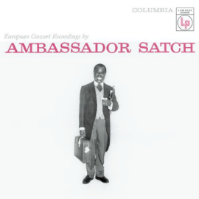 performing the music of Fats Waller. At this point, Glaser took Decca out of the picture and granted exclusive recording rights to Columbia. With Armstrong due to start a 3-month tour of Europe and Africa, Avakian decided to record the All-Stars for a new live album. Meanwhile, newsman Edward R. Murrow wanted to create a profile of Armstrong for his “See It Now” television program on Columbia’s sister company, CBS. Avakian took on the soundtrack project as well, and he scattered parts of the concerts across both LPs.
performing the music of Fats Waller. At this point, Glaser took Decca out of the picture and granted exclusive recording rights to Columbia. With Armstrong due to start a 3-month tour of Europe and Africa, Avakian decided to record the All-Stars for a new live album. Meanwhile, newsman Edward R. Murrow wanted to create a profile of Armstrong for his “See It Now” television program on Columbia’s sister company, CBS. Avakian took on the soundtrack project as well, and he scattered parts of the concerts across both LPs.
The first concert that Avakian recorded was an October 30, 1955 performance at the Concertgebouw in Amsterdam. Avakian seemed hyper-critical of this concert, noting that tempos dragged at spots, and there were episodes that should be edited out. Riccardi notes that a complete, but low-fidelity, recording of the concert disputes Avakian’s impressions, but since Columbia’s original session reels have vanished, there was no way to include these pieces except as originally issued. Still, Mosaic rescues a bass solo cut from the LP version of “Indiana” (on “Satchmo the Great”), and issues a fine “Back O’Town Blues” for the first time. The All-Stars, now comprising Armstrong, Trummy Young, Edmond Hall, Billy Kyle, Shaw, and Barrett Deems, are a tight ensemble, capable of rhythmic subtleties like the 1947 group, but also able to pump up the energy when needed. Hall was the newest member of the group, and his incisive feature on “Dardanella” is one of the highlights of this concert. Young was no Teagarden—who was?—but despite his sometimes blatty tone, he could effortlessly float ideas over the ground beat, as he does on a breakneck version of “Undecided”.
Avakian’s pickiness led him to change his approach for the next two sessions, recorded in Milan and Los Angeles. Both were intended to be studio sessions, but at the Milan session—recorded after Armstrong and the All-Stars had played three concerts in one day—the musicians brought along an entourage who were eventually allowed to cheer on the performances (On “Lonesome Road”, Armstrong even invites them onstage to be his background chorus!). While the audience adds to the fervor of the performance, the whole thing still sounds like a recording session due to the multiple takes of several tunes. Although Avakian only used four of the tracks for “Ambassador Satch” (mostly composite versions edited from multiple takes) about an hour of the session is included on the Mosaic set. Armstrong performs a spectacular remake of “West End Blues” and each member of the All-Stars shines on an energetic version of “Royal Garden Blues”. Young’s feature is a smoothly-swinging version of “You Can Depend On Me” and Hall makes a few changes to his “Dardanella” solo during two previously unissued takes. The band recorded their first version of “The Faithful Hassar” at this session, but thankfully, Riccardi and Mosaic only offer Avakian’s composite takes rather than the five original takes from which they were assembled. Because there is little musical difference between the takes, the sheer repetition dulls the overall effect of this session. Considering the mammoth size of this collection, I wish that Mosaic would have exercised a little more judgment regarding the takes that were absolutely essential to this set.
By the time of the Los Angeles studio session on January 24, 1956, most of the “Ambasador Satch” playlist had been finalized. Thus, the musicians focused on four tunes, two of which would complete the LP, and the remaining two for a single release. This time there was no audience, so Avakian sweetened the LP tracks with canned applause, and had Armstrong record a few fake stage announcements. The band plays well, especially on “All of Me” and “When the Red, Red Robin”, and they approximate the fire that they would have had with an audience present. Once again, the alternate takes seem redundant, and the original composite takes might have been a better choice. Before leaving the “Ambassador Satch” sessions, mention should be made of two curious items. One is an extended interview between Armstrong and Avakian which was recorded in LA, but made to sound as if it was recorded in Milan. The other is a pair of French announcements Armstrong made at Avakian’s request during the Milan session. Riccardi praises Avakian for “covering all bases”, but there’s no explanation as to why Avakian was trying to pass off an Italian recording as a French performance, or being deliberately deceptive in the interview. In both cases, the material was not issued at the time, so while each item is quite charming, the lingering questions remain.
After “Satchmo the Great” played on “See It Now”, Murrow and his co-producer Fred Friendly decided to expand the television segment into a feature film. The additional performances on the soundtrack were taken from concerts in New York, London, and Accra (Ghana). The buoyant version of “Mack the Knife” is the only song that has been legitimately issued from the Carnegie Hall concert of March 17, 1956. It was offered to Avakian by a private collector, but the London performance of “Bucket’s Got a Hole in It” and the Ghana performances of 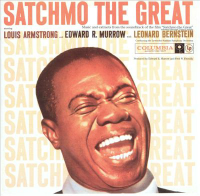 “All For You, Louis” (recorded at the airport with a group of local musicians) and “Royal Garden Blues” (from a concert later that day) were recorded by Murrow’s cameras and by Avakian’s brother, Aram. Mosaic obtained Aram’s reels which were complete and did not include Murrow’s narration. The Ghana performances are quite exhilarating, and on the airport recording, the love between Armstrong and the large crowd comes through clearly through the somewhat distorted recording. The Mosaic set also includes all of the surviving portions of Murrow’s Paris interview with Armstrong. Placed directly before Avakian’s “Milan” interview, it shows that Armstrong could talk with ease to anyone, but he was obviously more relaxed with Avakian.
“All For You, Louis” (recorded at the airport with a group of local musicians) and “Royal Garden Blues” (from a concert later that day) were recorded by Murrow’s cameras and by Avakian’s brother, Aram. Mosaic obtained Aram’s reels which were complete and did not include Murrow’s narration. The Ghana performances are quite exhilarating, and on the airport recording, the love between Armstrong and the large crowd comes through clearly through the somewhat distorted recording. The Mosaic set also includes all of the surviving portions of Murrow’s Paris interview with Armstrong. Placed directly before Avakian’s “Milan” interview, it shows that Armstrong could talk with ease to anyone, but he was obviously more relaxed with Avakian.
The feature version of “Satchmo the Great” closed with Armstrong and the All-Stars performing an orchestral arrangement of the “St. Louis Blues” with Leonard Bernstein and the New York Philharmonic. As it turned out, there was much more music recorded at Lewissohn Stadium on July 14, 1956 than previously documented. Mosaic’s presentation of this day’s work fills an entire CD and includes an impromptu performance by Armstrong and the All-Stars recorded between the afternoon rehearsal and the evening concert. This relaxed and swinging performance found Armstrong gliding through medium-tempo versions of “Way Down Yonder in New Orleans”, “Mahogany Hall Stomp”, “Blueberry Hill” and “Mack the Knife”. The rhythm section is anchored by the solid bass of Dale Jones, who had replaced Shaw in late May 1956. Jones was a very good soloist and his bass solos—usually trimmed out of the LPs by Avakian—have been restored on the Mosaic set. Apparently, a set by the All-Stars at the evening concert went unrecorded by both Avakian’s microphones and Murrow’s cameras. Everyone was in place when Armstrong, Bernstein, the All-Stars and the orchestra teamed up for the “St. Louis Blues”. The version of this piece on the soundtrack LP was different than the film version, so Mosaic includes three complete versions of this 10-minute arrangement. The final version was necessitated by a camera which lost power in an earlier take. While the cameramen reloaded film, Armstrong—ever the dedicated showman—entertained the audience with impromptu versions of “When the Saints Go Marching In” and “Beale Street Blues”. By then, the All-Stars were ready to play more straight-ahead jazz, and the rhythmic energy they generated clearly electrified the already excited audience.
Two weeks before the Lewissohn concert, Armstrong and the All-Stars performed a benefit concert at the Medina Temple in Chicago. Avakian was 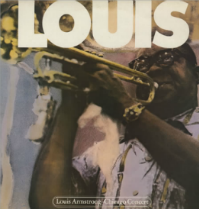 having issues with the demanding Joe Glaser, and showed little enthusiasm towards recording the concert. As Avakian feared, the hastily written script (read by Helen Hayes) was not suitable for repeated listening, and Armstrong and the All-Stars played many of the tunes that they had already recorded in Europe. To make matters worse, Armstrong played off-mic on parts of the recordings, making them unusable at the time. Avakian salvaged a couple of tracks (not identifying them as Chicago recordings) and shelved the rest. The master reels were nearly discarded in 1980, when they were discovered by producer Michael Brooks and subsequently issued as a 2-LP set. The portions Brooks left off the LPs were later re-inserted into the program for the CD reissue. That is the same version that now appears on this Mosaic set. Despite occasional microphone issues, the Chicago concert is an important documentation of this edition of the All-Stars, and it is an entertaining two hours of music. There are fine band versions of “Black and Blue”, “Struttin’ with Some Barbecue”, “On the Sunny Side of the Street” and a very good remake of “West End Blues”. “The Faithful Hassar” makes a return appearance, but while Avakian had penned lyrics for the song (renamed “Six Feet Four” and recorded by Armstrong at the LA “Ambassador Satch” session), Armstrong leaves out the lyric, singing the song’s title surrounded with scat passages. Young and Armstrong have a lot of fun with their duet on “Rockin’ Chair” and the All-Stars strike up a powerful groove on “Bucket’s Got a Hole in It”. Amongst the solo features, Deems’ loose-limbed drum solo on “Stompin’ at the Savoy” is a highlight, as is Kyle’s intensely swinging version of “Perdido”. And Velma Middleton, whose solos were usually cut from Avakian’s live Armstrong recordings, performs on three pieces, including a blues solo and two duets with Armstrong.
having issues with the demanding Joe Glaser, and showed little enthusiasm towards recording the concert. As Avakian feared, the hastily written script (read by Helen Hayes) was not suitable for repeated listening, and Armstrong and the All-Stars played many of the tunes that they had already recorded in Europe. To make matters worse, Armstrong played off-mic on parts of the recordings, making them unusable at the time. Avakian salvaged a couple of tracks (not identifying them as Chicago recordings) and shelved the rest. The master reels were nearly discarded in 1980, when they were discovered by producer Michael Brooks and subsequently issued as a 2-LP set. The portions Brooks left off the LPs were later re-inserted into the program for the CD reissue. That is the same version that now appears on this Mosaic set. Despite occasional microphone issues, the Chicago concert is an important documentation of this edition of the All-Stars, and it is an entertaining two hours of music. There are fine band versions of “Black and Blue”, “Struttin’ with Some Barbecue”, “On the Sunny Side of the Street” and a very good remake of “West End Blues”. “The Faithful Hassar” makes a return appearance, but while Avakian had penned lyrics for the song (renamed “Six Feet Four” and recorded by Armstrong at the LA “Ambassador Satch” session), Armstrong leaves out the lyric, singing the song’s title surrounded with scat passages. Young and Armstrong have a lot of fun with their duet on “Rockin’ Chair” and the All-Stars strike up a powerful groove on “Bucket’s Got a Hole in It”. Amongst the solo features, Deems’ loose-limbed drum solo on “Stompin’ at the Savoy” is a highlight, as is Kyle’s intensely swinging version of “Perdido”. And Velma Middleton, whose solos were usually cut from Avakian’s live Armstrong recordings, performs on three pieces, including a blues solo and two duets with Armstrong.
Between the Chicago and Lewissohn concerts, Avakian recorded Armstrong at the Newport Jazz Festival. This was the same edition of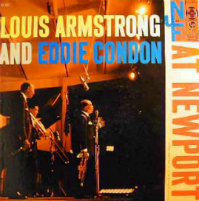 the festival that featured Duke Ellington’s rousing performance of “Diminuendo and Crescendo in Blue”. Both Columbia and the Voice of America were there to record, and just as Ellington’s saxophonist Paul Gonsalves had played his marathon solo into the VOA microphone instead of Columbia’s, Armstrong made the same mistake when singing his vocals during his own set. To remedy the issue, Mosaic lifted many of the vocals from the VOA tape and seamlessly mixed them into the Columbia recording. The concert received a vicious review from Jack Tracy in Downbeat, and the eventual Columbia LP (shared with Eddie Condon’s Newport set) only featured two tracks from Newport, along with an edited version of “Indiana” from Chicago and a composite version of “Mack the Knife” from a studio session and Lewissohn. While Columbia might not have been able to salvage the vocal tracks using 1956 technology, there were plenty of fine instrumental tracks they might have included. The Newport version of “Indiana” is faster, edgier and far more exciting than the Chicago version, and “Tin Roof Blues” has a deep, sustaining groove. Since the solo features usually included the entire band, almost any of them could have been issued. Along with the two Newport tracks that were released—a new medley of “Bugle Blues” and “Ole Miss”, and a version of “Whispering”—Avakian could have issued much more of this performance. The recording proves that Armstrong and the All-Stars were playing at their usual high level, and while the deteriorating relationship with Glaser may have clouded Avakian’s judgment, his first responsibility was to Armstrong, and the release of more of the Newport performances would have been a direct dispute of Tracy’s mean-spirited notice.
the festival that featured Duke Ellington’s rousing performance of “Diminuendo and Crescendo in Blue”. Both Columbia and the Voice of America were there to record, and just as Ellington’s saxophonist Paul Gonsalves had played his marathon solo into the VOA microphone instead of Columbia’s, Armstrong made the same mistake when singing his vocals during his own set. To remedy the issue, Mosaic lifted many of the vocals from the VOA tape and seamlessly mixed them into the Columbia recording. The concert received a vicious review from Jack Tracy in Downbeat, and the eventual Columbia LP (shared with Eddie Condon’s Newport set) only featured two tracks from Newport, along with an edited version of “Indiana” from Chicago and a composite version of “Mack the Knife” from a studio session and Lewissohn. While Columbia might not have been able to salvage the vocal tracks using 1956 technology, there were plenty of fine instrumental tracks they might have included. The Newport version of “Indiana” is faster, edgier and far more exciting than the Chicago version, and “Tin Roof Blues” has a deep, sustaining groove. Since the solo features usually included the entire band, almost any of them could have been issued. Along with the two Newport tracks that were released—a new medley of “Bugle Blues” and “Ole Miss”, and a version of “Whispering”—Avakian could have issued much more of this performance. The recording proves that Armstrong and the All-Stars were playing at their usual high level, and while the deteriorating relationship with Glaser may have clouded Avakian’s judgment, his first responsibility was to Armstrong, and the release of more of the Newport performances would have been a direct dispute of Tracy’s mean-spirited notice.
The final concert on the Mosaic set captures Armstrong at Newport in 1958. The trumpeter, who had had issues with festival producer George Wein in previous years, was finally treated like a star. He did a guest appearance with the Newport International Youth Band, played an hour-long set with 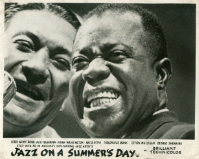 the All-Stars, and reunited with Teagarden and Hackett as the finale of the festival. By this time, Avakian had left Columbia, but he acted as a musical advisor on the documentary made of the festival, “Jazz on a Summer’s Day”. For years, the only records of this performance were the film and a few isolated LPs, and it’s hard to understand why. The sound is very good, and there are many excellent performances, starting with the Youth Band’s collaboration on “Sunny Side of the Street”, and including the four songs from the film (“Tiger Rag”, “Lazy River”, “Rockin’ Chair”—again with Teagarden—and “Saints”). While the All-Stars had changed considerably since 1956 (Peanuts Hucko replaced Hall, Mort Herbert was the new bassist, and Danny Barcelona was on drums), they still put on a great show, and the group’s repertoire now included music from the film “High Society”, and standards like “These Foolish Things”, “Girl of My Dreams” and “After You’ve Gone”. And since the recording was in stereo, Columbia could have released brand-new versions of these songs for the quickly growing audience of hi-fi enthusiasts. Without doubt, the performance required editing—if for no other reason than to excise Armstrong’s occasional profanities—but there is no valid excuse why most of this music has remained unissued until now. Of course, that is all the more reason to be thankful for Mosaic!
the All-Stars, and reunited with Teagarden and Hackett as the finale of the festival. By this time, Avakian had left Columbia, but he acted as a musical advisor on the documentary made of the festival, “Jazz on a Summer’s Day”. For years, the only records of this performance were the film and a few isolated LPs, and it’s hard to understand why. The sound is very good, and there are many excellent performances, starting with the Youth Band’s collaboration on “Sunny Side of the Street”, and including the four songs from the film (“Tiger Rag”, “Lazy River”, “Rockin’ Chair”—again with Teagarden—and “Saints”). While the All-Stars had changed considerably since 1956 (Peanuts Hucko replaced Hall, Mort Herbert was the new bassist, and Danny Barcelona was on drums), they still put on a great show, and the group’s repertoire now included music from the film “High Society”, and standards like “These Foolish Things”, “Girl of My Dreams” and “After You’ve Gone”. And since the recording was in stereo, Columbia could have released brand-new versions of these songs for the quickly growing audience of hi-fi enthusiasts. Without doubt, the performance required editing—if for no other reason than to excise Armstrong’s occasional profanities—but there is no valid excuse why most of this music has remained unissued until now. Of course, that is all the more reason to be thankful for Mosaic!
In the final analysis, this Mosaic set will certainly validate Riccardi’s assertions that Louis Armstrong’s All-Star recordings rate with his early masterpieces. Riccardi’s liner notes are simultaneously joyful and informative. While I can’t agree with all of Avakian’s editing decisions or his history of deceptive practices, there is little doubt that he produced some of Armstrong’s finest performances. The remarkable consistency of Armstrong and the All-Stars gave Avakian a lot of freedom in selecting performances, and we can be thankful that so much of the raw material has survived despite years of turbulence in the recording industry. As usual, Mosaic has done a brilliant job in bringing this music to the public. Perhaps as an encore, Mosaic could collect the complete session reels of the Armstrong/Avakian Columbia studio sessions, including all of the urviving material from the Handy, Waller and Lotte Lenya albums. The excerpts released so far all hint at another treasure trove of Armstrong gems.